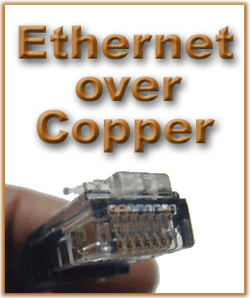Many businesses are analyzing if switching to fiber optic services is worthwhile due to limitations with their current internet and private line bandwidth. However, there’s now an additional choice: Ethernet over Copper (EoC).
You might be surprised to learn that EoC’s bandwidth and affordability put it in a similar league as fiber optics.
The traditional fiber optic service relies on the SONET (Synchronous Optical NETwork) standard, created by the telephone industry. SONET starts at OC-3 speed, offering 155 Mbps, three times faster than a DS3 or T3 service. Crucially, SONET is compatible with T-Carrier standards, enabling seamless transport of T1 and DS3 services over SONET networks. This compatibility allows these copper-based services to utilize fiber optic carriers for long-distance connections.
Fiber optic cable offers almost limitless bandwidth potential. A typical fiber optic cable doesn’t just have a few fiber strands; it contains dozens or even hundreds of strands. This is because the major cost lies in the infrastructure: digging trenches, laying conduit, and pulling the fiber optic cable. The difference in cost between a small and large fiber cable is insignificant compared to the installation costs.
When it comes to bandwidth, each fiber strand can handle 10 Gbps or more. Implementing technologies like coarse or dense wavelength division multiplexing, which transmit multiple beams per fiber strand, can boost bandwidth capacity tenfold to a hundredfold. Future technology holds the potential to increase this capacity even further, ensuring businesses won’t reach the limits of fiber optic cable capacity anytime soon.
However, there’s a catch. The high installation cost is the primary reason why nearly two-thirds of business locations haven’t adopted fiber optic services. Businesses need to be situated near a carrier’s service area and bear the cost of installing a dedicated connection and termination equipment. Although more buildings are being equipped with fiber optic service daily, universal fiber optic connectivity, like electricity and telephone lines, is still far off.
This is where EoC comes into play. One of its biggest advantages is the potential to eliminate construction costs. EoC uses existing twisted-pair telephone wire connecting your building to the nearest telephone company central office (CO). While residential lines usually have two pairs, business cables often have 25 or more copper pairs for telephone lines, T1 lines, or EoC, provided your CO has the necessary termination equipment.
If EoC is available in your location, the next question is: what are the options and costs?
EoC providers utilize up to eight unused copper pairs to provide service. More pairs translate to higher bandwidth, depending on the CO equipment and the distance from the CO. Within a few miles, speeds of 10 Mbps, 20 Mbps, or even 45 Mbps are achievable over eight pairs. In some cases, speeds can surpass 100 Mbps if you’re very close to the CO, a common scenario in metropolitan areas. The 45 Mbps option is popular as a direct substitute for DS3 bandwidth often carried over fiber.
As for cost, EoC is usually half the price of T-Carrier or SONET bandwidth, or you can double your bandwidth for the same price. Many smaller companies are upgrading to 3 Mbps for the cost of their old 1.5 Mbps T1 line. Along with lower monthly fees, construction costs are minimal or non-existent compared to installing new fiber optic infrastructure.
EoC effectively rivals lower-tier fiber optic services. Limited options have often forced companies to upgrade from T1 to DS3 to OC3, even when they only needed 10 or 20 Mbps. Ethernet services are much more scalable, increasing in increments of 1 or 5 Mbps instead of large leaps. Often, increasing your bandwidth is as easy as contacting your provider, and no equipment changes are needed as long as you stay below the maximum port bandwidth.
If you’re considering EoC as an alternative to fiber optics, compare current prices for Ethernet over Copper, Fiber, and SONET optical services to determine the best fit for your business location.


